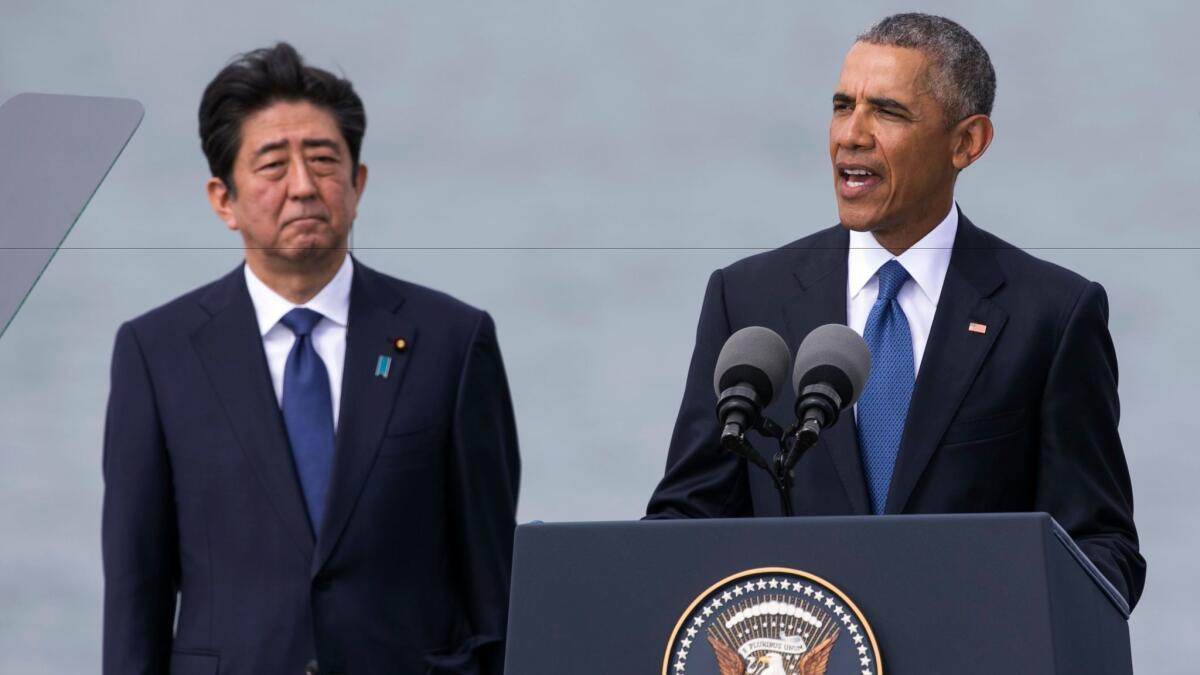At Pearl Harbor, Obama says ‘we must resist the urge to demonize those who are different’

- Share via
Reporting from Pearl Harbor, Hawaii — President Obama and Japanese Prime Minister Shinzo Abe scattered petals together on the waters of Pearl Harbor on Tuesday in a symbolic act aimed at laying to rest the enmity of the Japanese attack 75 years ago that drew the U.S. into World War II.
In a moment consumed with history, both leaders were fixed on the future. They expressed concern that the lessons of the war might be forgotten amid a shifting world order and the anti-internationalist sentiment that has swept over politics around the globe, most notably with the ascendance of President-elect Donald Trump.
“Even when hatred burns hottest, even when the tug of tribalism is at its most primal, we must resist the urge to turn inward,” Obama said. “We must resist the urge to demonize those who are different.”
The ceremony was conceived of as an affirmation of close U.S. relations with Japan, once a bitter wartime enemy, and Obama and Abe underscored the importance of building bonds between nations and the risks of slipping into isolationism. Their remarks also appeared to be warnings for Trump, whose divisive campaign took aim at longstanding alliances and stoked fears with harsh rhetoric about immigrants and minorities.
“Ours is an alliance of hope that will lead us to the future,” Abe said, speaking to World War II veterans after paying tribute at the Pearl Harbor memorial. “What has bonded us together is the power of reconciliation, made possible through the spirit of tolerance.”
Obama, as has been his custom in public remarks since the election, argued for the merits of his own worldview without naming Trump, saying, “There is more to be won in peace than in war.”
During the campaign and since his election, Trump has challenged assumptions about U.S. commitments to the security of Asia. One of the central tenets of Obama’s foreign policy was a commitment of resources toward Asia with an eye toward countering the rise of China.
But Trump has obliterated long-established protocols. He spoke with Taiwanese leader Tsai Ing-wen despite the U.S. policy of officially acknowledging no Chinese government other than the one in Beijing. And when he met with Abe last month in New York, Trump brought not a battalion of Asia experts but rather his daughter Ivanka.
Trump also promised last week to expand America’s nuclear arsenal after decades of a deliberate shrinking of the American and Russian stockpiles.
“Let it be an arms race,” he told an MSNBC host, unnerving leaders in Asia, where North Korea and China are growing more aggressive.
Though the U.S.-Japan relationship has evolved considerably in recent decades, the healing over World War II has gone more slowly, making Abe’s visit to Pearl Harbor, and Obama’s trip in May to Hiroshima, Japan, the site of one of the two nuclear attacks that ended the war, significant gestures.
Abe became the first Japanese prime minister to make a highly publicized visit to the USS Arizona Memorial, though three of his predecessors are thought to have visited Pearl Harbor more quietly.
Under a bright, sunny sky, Abe and Obama rode a small boat to the white memorial building in the harbor that looks out over the sunken remains of the Arizona, attacked by the Japanese on Dec. 7, 1941, killing 2,403 people and thrusting the U.S. into World War II. Abe laid a wreath in honor of the dead.
Veterans of the war gathered across the harbor to hear Obama and Abe deliver their brief speeches.
Among those in the crowd was Sterling Cale, 95, a sailor at Pearl Harbor on the day of the attack.
Of those killed that day, 1,177 were crew members of the Arizona. It was Cale’s job to pull bodies from the burning battleship.
He recalled watching ashes rising from the deck of the ship. He and his crew were able to remove about 100 bodies.
On Tuesday, he looked across the water where the Arizona is submerged.
He did not come hoping to hear Abe apologize, he said.
“‘Sorry’ is just a word,” Cale said. “What matters more is the action of coming here and going out there with our commander in chief. That says more than words.”
Abe did not issue a formal apology, even as he detailed the horror of the sinking of the Arizona.
“Each and every one of those servicemen had a mother and a father anxious about his safety,” Abe said. “Many had wives and girlfriends they loved, and many must have had children they would have loved watching grow up.”
“Rest in peace, precious souls of the fallen,” he went on. “I offer my sincere and everlasting condolences to the souls of those who lost their lives here.”
After that somber expression of sorrow, Obama stepped to the lectern and declared the site a symbol of reconciliation.
“Today, the alliance between the United States and Japan, bound not only by shared interests, but also rooted in common values, stands as the cornerstone of peace and stability in the Asia Pacific, and a force for progress around the globe,” Obama said.
In what may be his final visit with a world leader before he leaves office in January, Obama expressed hope.
“As nations and as people, we cannot choose the history that we inherit,” he said. “But we can choose what lessons to draw from it and use those lessons to chart our own futures.”
Follow @cparsons for news about the White House.
Will the Fed’s Janet Yellen ‘take away the punch bowl’ after Trump takes office?
As Democrats ponder their future, Joe Biden makes a plea for a focus on the middle class
Obama says he could have beaten Trump
UPDATES:
5:10 p.m.: This story was updated with more comments from Obama and Abe.
This story was originally published at 3:50 p.m.
More to Read
Get the L.A. Times Politics newsletter
Deeply reported insights into legislation, politics and policy from Sacramento, Washington and beyond. In your inbox three times per week.
You may occasionally receive promotional content from the Los Angeles Times.











